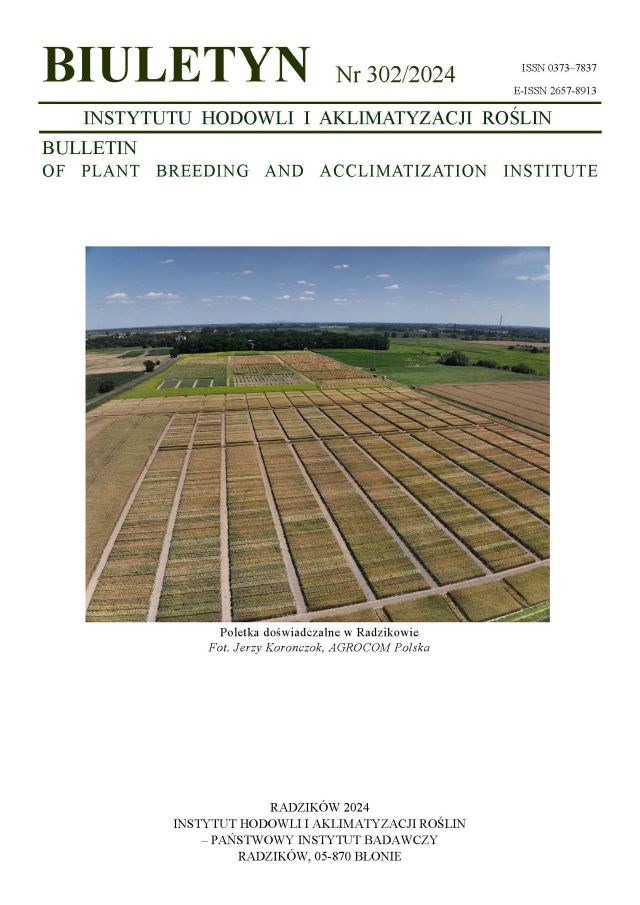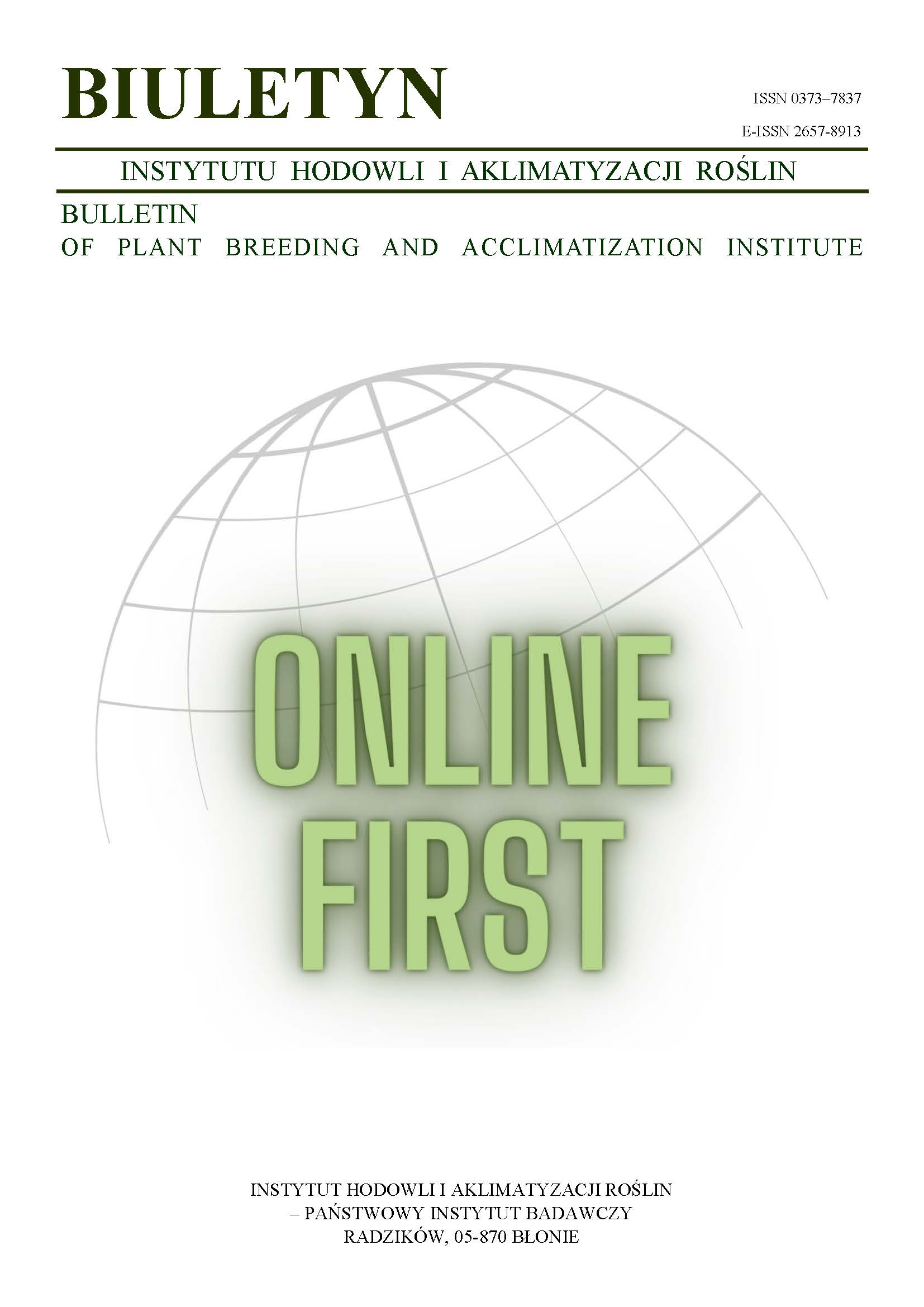The influence of 2.4 D and picloram on androgenesis of winter triticale (Triticosecale Wittm.)
Agnieszka Katańska
kgihr@up.poznan.plKatedra Genetyki i Hodowli Roślin, Akademia Rolnicza w Poznaniu (Poland)
Zbigniew Broda
Katedra Genetyki i Hodowli Roślin, Akademia Rolnicza w Poznaniu (Poland)
Abstract
The research was carried on cultivars of winter triticale: Bogo, Hewo, Tornado, Kitaro, Sekundo, Kazo and one breeding line SZDB 154. It aimed at determination of the influence of 2.4 D and picloram mixture concentration on effectiveness of androgenesis in selected cultivars of winter triticale. In the experiment the medium C17 (Wang and Chen, 1983) with 2.4 D and picloram was applied at the following concentration levels: 1 mg 2.4 D + 0.5 mg picloram / 1 litre of medium; 1 mg 2.4 D + 1.0 mg picloram / 1 litre of medium;1 mg 2.4 D + 1.5 mg picloram / 1 litre of medium. Higher concentration of auxine mixture caused better callus induction. The highest effectiveness of androgenesis was observed in Kazo on the C17 medium with 1 mg of 2.4 D / 1 litre of medium. The lowest effectiveness was observed in the Kitaro cultivar. The influence of genotype on androgenesis induction was distinct. Independently on the level of the auxine concentration, embriogenic callus developed most intensely in Kazo, and least intensely in Kitaro. In the experiment, the highest number of regenerated plants was obtained in Kazo on the C17 medium with 1 mg of 2.4 D + 1.5 mg of picloram per one litre medium.
Keywords:
androgenesis, anthers, auxine, in vitro, triticale, varietiesReferences
Hassawi D. S., Qi J., Liang G. H. 1990. Effects of Growth Regulator and Genotype on Production of Wheat and Triticale Polyhaploids from Anther Culture, Plant Breeding 104: 40 — 45.
DOI: https://doi.org/10.1111/j.1439-0523.1990.tb00400.x
Google Scholar
Hu Han. 1997. In vitro induced haploids production in higher plants, vol 4. Kluwer Dordrecht, The Netherlands: 73 — 97.
DOI: https://doi.org/10.1007/978-94-017-1862-2_3
Google Scholar
Kiviharju E. M., Tauriainem A. A. 1999. 2,4D-dichlorophenoxyacetic acid and kinetin in anther culture of cultivated and wild oats and their interspecific crosses: plant regeneration from A. sativa L. Plant Cell Reports 18: 582 — 588.
DOI: https://doi.org/10.1007/s002990050626
Google Scholar
Marsolais A. A., Kasha K. J. 1985. Callus induction from microspores: the role of sucrose and auxin in a barley ture culture medium. Can J. Bot. 63: 2209 — 2212.
DOI: https://doi.org/10.1139/b85-313
Google Scholar
Marciniak K. 1999. Wpływ mieszaniny auksyn w pożywce indukującej na efektywność androgenezy u pszenżyta ozimego. Materiały I Krajowej Konferencji: Haploidy i Linie Podwojonych Haploidów w Genetyce i Hodowli Roślin. PTG — PAN: 17 ss.
Google Scholar
Rogalska S. Mikulski W. 1995. Androgeneza u pszenżyta (X Triticosecale Wittm.). Biul. IHAR 195/196: 21 — 31.
Google Scholar
Sharma G. C., Wang W. C. and Sapra V. T. 1982. Effect of genotype, media and temperature pretreatment on callus initiation in triticale, wheat, and rye anther cultures. Cereal Research Comm. 10/3–4: 143 — 150.
Google Scholar
Wang, Chen. 1983. Preliminary study on prediction of height of pollen H2 generation in winter wheat grown in the field. Acta Agron. sin. 9: 283 — 284.
Google Scholar
Zheng, Konzak. 1999. Effect of 2,4D-dichlorofenoxyacetic acid on callus induction and plant regeneration in anther culture of wheat (Triticum aestivum L.) Plant Cell Reports 19, (1): 69 — 73.
DOI: https://doi.org/10.1007/s002990050712
Google Scholar
Zhuang J. J., Jia X. 1983. Increasing differentiation frequencies in wheat pollen callus. In: Hu H. & Vega MR (eds) Cell and Tissue Culture Techniques for Cereal Crop Improvement (p 431)Science Press, Beijing.
Google Scholar
Authors
Agnieszka Katańskakgihr@up.poznan.pl
Katedra Genetyki i Hodowli Roślin, Akademia Rolnicza w Poznaniu Poland
Authors
Zbigniew BrodaKatedra Genetyki i Hodowli Roślin, Akademia Rolnicza w Poznaniu Poland
Statistics
Abstract views: 72PDF downloads: 27
License
Copyright (c) 2005 Agnieszka Katańska, Zbigniew Broda

This work is licensed under a Creative Commons Attribution-ShareAlike 4.0 International License.
Upon submitting the article, the Authors grant the Publisher a non-exclusive and free license to use the article for an indefinite period of time throughout the world in the following fields of use:
- Production and reproduction of copies of the article using a specific technique, including printing and digital technology.
- Placing on the market, lending or renting the original or copies of the article.
- Public performance, exhibition, display, reproduction, broadcasting and re-broadcasting, as well as making the article publicly available in such a way that everyone can access it at a place and time of their choice.
- Including the article in a collective work.
- Uploading an article in electronic form to electronic platforms or otherwise introducing an article in electronic form to the Internet or other network.
- Dissemination of the article in electronic form on the Internet or other network, in collective work as well as independently.
- Making the article available in an electronic version in such a way that everyone can access it at a place and time of their choice, in particular via the Internet.
Authors by sending a request for publication:
- They consent to the publication of the article in the journal,
- They agree to give the publication a DOI (Digital Object Identifier),
- They undertake to comply with the publishing house's code of ethics in accordance with the guidelines of the Committee on Publication Ethics (COPE), (http://ihar.edu.pl/biblioteka_i_wydawnictwa.php),
- They consent to the articles being made available in electronic form under the CC BY-SA 4.0 license, in open access,
- They agree to send article metadata to commercial and non-commercial journal indexing databases.
Most read articles by the same author(s)
- Sylwia Mikołajczyk, Dorota Weigt, Agnieszka Tomkowiak, Zbigniew Broda, Jan Bocianowski, Haploidization of the rye — the molecular diagnostics and the influence of nanomolecules on supporting the induction and regeneration of plants in in vitro conditions , Bulletin of Plant Breeding and Acclimatization Institute: No. 286 (2019): Special issue
- Anna Ćwiklińska, Zbigniew Broda, Jan Bocianowski, Comparative analysis of the features of wild species within the genus Secale for widening genetic variability to be utilized in breeding , Bulletin of Plant Breeding and Acclimatization Institute: No. 252 (2009): Regular issue
- Zbigniew Broda, Agnieszka Tomkowiak, Krzysztof Moliński, Józef Adamaczyk, The evaluation of genetic similarity between parental components of maize hybrids by means of molecular markers AFLP and RAPD , Bulletin of Plant Breeding and Acclimatization Institute: No. 244 (2007): Regular issue
- Zbigniew Broda, Agnieszka Dobrzycka, Jan Bocianowski, Genetic similarity of various populations of alfalfa (Medicago sativa L. sl.) and their seed yield potential , Bulletin of Plant Breeding and Acclimatization Institute: No. 252 (2009): Regular issue
- Anna Ćwiklińska, Zbigniew Broda, Danuta Kurasiak-Popowska, Differentiation of flowering biology among species of rye in the genus Secale , Bulletin of Plant Breeding and Acclimatization Institute: No. 251 (2009): Regular issue
- Zbigniew Broda, Danuta Kurasiak-Popowska, Aleksandra Kowalska, Anna Ćwiklińska, The analysis of genetic similarity among Secale species , Bulletin of Plant Breeding and Acclimatization Institute: No. 247 (2008): Regular issue
- Zbigniew Broda, Agnieszka Dobrzycka, The study of self-incompatibility and genetic similarity of genetically differentiated forms of alfalfa (Medicago sativa L.) , Bulletin of Plant Breeding and Acclimatization Institute: No. 245 (2007): Regular issue
- Zbigniew Broda, Agnieszka Tomkowiak, Danuta Mackiewicz, Anita Dobek, Henryk Woś, Janina Woś, Roman Warzecha, Krystyna Warzecha, Molecular marker based study of genetic diversity of triticale lines suitable for hybrid breeding , Bulletin of Plant Breeding and Acclimatization Institute: No. 237/238 (2005): Regular issue
- Agnieszka Tomkowiak, Zbigniew Broda, Krzysztof Moliński, A choice of the mathematical model for the relationship between heterosis effect of F1 hybrids and genetic distance of rye and triticale parental lines , Bulletin of Plant Breeding and Acclimatization Institute: No. 250 (2008): Regular issue
- Danuta Mackiewicz, Zbigniew Broda, Estimation of breeding suitability of hybrids of rye (Secale cereale L.) with wild species from the genus Secale , Bulletin of Plant Breeding and Acclimatization Institute: No. 231 (2004): Regular issue














